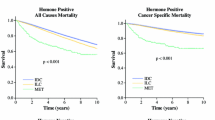Abstract
Background
Metaplastic breast cancer (MBC) is characterized by various combinations of adenocarcinoma, mesenchymal, and other epithelial components. It was officially recognized as a distinct pathologic diagnosis in 2000. With few published reports, we hypothesized that MBC may have markedly different characteristics at presentation than typical infiltrating ductal carcinoma (IDC) and may be managed differently.
Methods
Data from patients with MBC and IDC reported to the National Cancer Database from January 2001 through December 2003 were reviewed for year of diagnosis, patient age, race/ethnicity, tumor size, nodal status, American Joint Committee on Cancer (AJCC) stage, tumor grade, hormone receptor status, and initial treatment, and were analyzed statistically by the Pearson χ2 test.
Results
A total of 892 patients with MBC and 255,164 patients with IDC were identified. The group with MBC was older (mean age, 61.1 vs. 59.7 years; P = .001), had a significantly increased proportion of African American (14.1%, 126 of 892, vs. 10.2%, 25,900 of 255,164; odds ratio [OR], 1.455, P = .001) and Hispanic patients (5.5%, 49 of 892 vs. 3.9%, 9,947 of 255,164; OR, 1.817, P = .001), had fewer T1 tumors (29.5% vs. 65.2%), more N0 tumors (78.1% vs. 65.7%, OR, .5, P = .001), more poorly or undifferentiated tumors (67.8% vs. 38.8%), and fewer estrogen receptor–positive tumors (11.3% vs. 74.1%, OR, 22.4, P = .001) than the IDC group. Patients with MBC were treated with breast-conserving surgery less frequently than patients with IDC (38.5% vs. 55.8%, OR, 2.0, P = .001) because of the larger tumor size. Chemotherapy was used more often for patients with MBC (53.4% vs. 42.1%, OR, 1.6, P = .001) because of more advanced AJCC stage.
Conclusions
MBC is a rare tumor with different characteristics than IDC: it presents with larger tumor size, less nodal involvement, higher tumor grade, and hormone receptor negativity. Patients with MBC are treated more aggressively than IDC (more often with mastectomy and chemotherapy) because of a higher stage at presentation, but are being treated by the same principles as IDC. Follow-up will determine the long-term results of the current treatment.




Similar content being viewed by others

References
Fritz A, Percy C, Jack A, Solin LH, eds. (2000) International Classification of Diseases of Oncology. 3rd ed. Geneva: World Health Organization.
Pitts WC, Rojas VA, Gaffey MJ, et al. Carcinomas with metaplasia and sarcomas of the breast. Am J Clin Pathol 1991; 95:623–32
Kurian KM, Al-Nafussi Al. Sarcomatoid/metaplastic carcinoma of the breast: a clinicopathological study of 12 cases. Histopathology 2002; 40:58–64
Johnson TL, Kini SR. Metaplastic breast carcinoma: a cytohistologic and clinical study of 10 cases. Diagn Cytopathol 1996; 14:226–32
Gobbi H, Simpson JF, Borowsky A, Jensen RA, Page DL. Metaplastic breast tumors with a dominant fibromatosis-like phenotype have a high risk of local recurrence. Cancer 1999; 85:2170–82
Chao TC, Wang CS, Chen SC, Chen MF. Metaplastic carcinomas of the breast. J Surg Oncol 1999 ; 71:220–5
Bellino R, Arisio R, D’Addato F, et al. Metaplastic breast carcinoma: pathology and clinical outcome. Anticancer Res 2003; 23:669–73
Wargotz ES, Norris HJ. Metaplastic carcinomas of the breast. I. Matrix-producing carcinoma. Hum Pathol 1989; 20:628–35
Wargotz ES, Deos PH, Norris HJ. Metaplastic carcinomas of the breast. II. Spindle cell carcinoma. Hum Pathol 1989; 20:732–40
Wargotz ES, Norris HJ. Metaplastic carcinomas of the breast. III. Carcinosarcoma. Cancer 1989; 64:1490–9
Wargotz ES, Norris HJ. Metaplastic carcinomas of the breast. IV. Squamous cell carcinoma of ductal origin. Cancer 1990; 65:272–6
Wargotz ES, Norris HJ. Metaplastic carcinomas of the breast: V. Metaplastic carcinoma with osteoclastic giant cells. Hum Pathol 1990; 21:1142–50
Park JM, Han BK, Moon WK, et al. Metaplastic carcinoma of the breast: mammographic and sonographic findings. J Clin Ultrasound 2000; 28:179–86
Gunhan-Bilgen I, Memis A, Ustun EE, Zekioglu O, Ozdemir N. Metaplastic carcinoma of the breast: clinical, mammographic, and sonographic findings with histopathologic correlation. Am J Roentgenol 2002; 178:1421–5
Rayson D, Adjei AA, Suman VJ, Wold LE, Ingle JN. Metaplastic breast cancer: prognosis and response to systemic therapy. Ann Oncol 1999; 10:413–9
Oberman HA. Metaplastic carcinoma of the breast: a clinicopathologic study of 29 patients. Am J Surg Pathol 1987; 11:918–29
Saxena S, Bansal A, Mohil RS, Bhatnagar D. Metaplastic carcinoma of the breast—a rare breast tumour. Indian J Pathol Microbiol 2004; 47:217–20
Huvos AG, Lucas JC Jr, Foote FW Jr. Metaplastic breast carcinoma: rare form of mammary cancer. NY State J Med 1973; 73:1078–82
Grechi G, Pagnini P. Study of mammary gland neoplasms with an osteocartilaginous component. I. Cartilaginous metaplastic epiphenomena in the course of connective tissue malignancy. Arch De Vecchi Anat Patol 1965; 46:277–303
Author information
Authors and Affiliations
Corresponding author
Additional information
*Members of the Breast Disease Site Team are listed in Appendix 1.
Appendix 1
Appendix 1
Members of the Breast Disease Site Team of the Commission on Cancer, American College of Surgeons, are as follows: Kirby Bland, MD (Leader)—Birmingham, AL; Robert Kuske, MD (Associate Leader)—Scottsdale, AZ; George Sledge, MD (Associate Leader)—Indianapolis, IN; Paul Baron, MD—Charleston, SC; James Connolly, MD—Boston, MA; Rosemary Duda, MD—Boston, MA; Timothy Eberlein, MD—St. Louis, MO; Stephen Edge, MD—Buffalo, NY; James Edney, MD—Omaha, NE; Suzanne Klimberg, MD—Little Rock, AR; A. Marilyn Leitch, MD—Dallas, TX; Joseph Lipscomb, PhD—Atlanta, GA; Lisa Newman, MD—Ann Arbor, MI; Geoffrey Robb, MD—Houston, TX; Edward Sickles, MD—San Francisco, CA; Sonja Eva Singletary, MD—Houston, TX; David P. Winchester, MD—Chicago, IL.
Rights and permissions
About this article
Cite this article
Pezzi, C.M., Patel-Parekh, L., Cole, K. et al. Characteristics and Treatment of Metaplastic Breast Cancer: Analysis of 892 Cases from the National Cancer Data Base. Ann Surg Oncol 14, 166–173 (2007). https://doi.org/10.1245/s10434-006-9124-7
Received:
Accepted:
Published:
Issue Date:
DOI: https://doi.org/10.1245/s10434-006-9124-7



